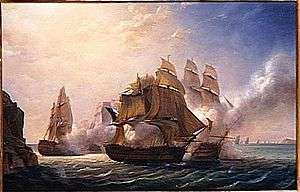HMS Caledonia (1808)
 | |
| History | |
|---|---|
| Name: | HMS Caledonia |
| Ordered: | 19 January 1797 |
| Builder: | Plymouth Dockyard |
| Laid down: | January 1805 |
| Launched: | 25 June 1808 |
| Renamed: | HMS Dreadnought, 1856 |
| Honours and awards: | Participated in bombardment of Algiers, 1816 |
| Fate: | Broken up, 1875 |
| General characteristics [1] | |
| Class and type: | Caledonia-class ship of the line |
| Tons burthen: | 2616 5⁄94 (bm) |
| Length: | 205 ft (62 m) (gundeck) |
| Beam: | 53 ft 6 in (16.31 m) |
| Depth of hold: | 23 ft 2 in (7.06 m) |
| Propulsion: | Sails |
| Sail plan: | Full rigged ship |
| Armament: |
|
HMS Caledonia was a 120-gun first-rate ship of the line of the Royal Navy, launched on 25 June 1808 at Plymouth.[1] She was Admiral Pellew's flagship in the Mediterranean.
She proved to be a very successful ship, and it was said that 'This fine three-decker rides easy at her anchors, carries her lee ports well, rolls and pitches quite easy, generally carries her helm half a turn a-weather, steers, works and stays remarkably well, is a weatherly ship, and lies-to very close.' She was 'allowed by all hands to be faultless'. In later years she was to become the standard design for British three-deckers.[2]
On 12 February 1814 she took part with HMS Boyne in a hot action against the French line-of-battle ship Romulus off Toulon; the French 74 managed to escape to Toulon by sailing close to the coast to avoid being surrounded.
In 1831 she was part of the Experimental Squadron of the Channel Fleet under Sir Edward Codrington. On 12 September that year she took part in an experiment whereby she was towed by the frigate HMS Galatea by means of hand-worked paddles alone.[3]
In 1856 she was converted to a hospital ship,[1] renamed Dreadnought and became the second floating Dreadnought Seamen's Hospital at Greenwich, where she remained until 1870. In 1871 she was briefly returned to service to accommodate patients recovering from the smallpox epidemic of that year. She was broken up in 1875.[1]
Notes
References
- Lavery, Brian (2003) The Ship of the Line - Volume 1: The development of the battlefleet 1650-1850. Conway Maritime Press. ISBN 0-85177-252-8.
- Lavery, Brian (1989) Nelson's Navy, The Ships, Men and Organisation 1793-1815. Conway Maritime Press. ISBN 0-85177-521-7.
- Lyon, David and Winfield, Rif (2004) The Sail and Steam Navy List: All the Ships of the Royal Navy 1815-1889. Chatham Publishing, London. ISBN 1-86176-032-9.